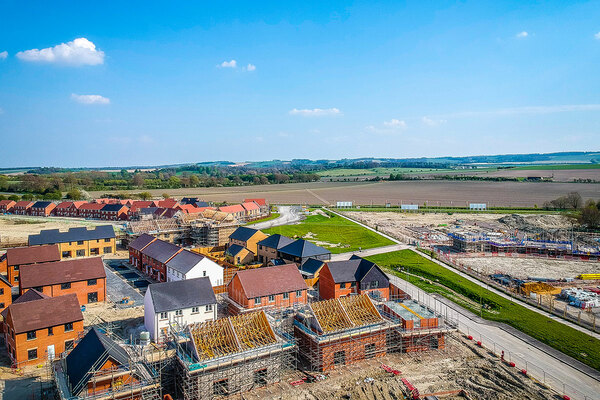You are viewing 1 of your 1 free articles
A 300,000 homes target is not the way to solve the housing crisis
The government’s target to build 300,000 homes a year may sound appealing, but it is too blunt a tool to help solve the housing crisis and is leading to unhelpful policymaking, argues Nathaniel Barker
My most controversial housing opinion is that the government’s target to build 300,000 homes a year is madness and should be scrapped.
I recently ventured to voice this opinion on Twitter and received what I would describe as a medium-level pasting. But I stand by my statement, and here’s why.
First: I am not anti-housebuilding (probably my favourite response to the above-mentioned Tweet was: “Bloke writing for a housing magazine thinks we shouldn’t build more houses? We are through the looking glass now”).
The evidence is clear that in England we have seen a severe shortfall in development over recent decades. Accelerating housebuilding to catch up is therefore a must.
I am not a closet nimby, quaking in my boots at the prospect of so many new builds springing up across this green and pleasant land.
Instead, I think the target is mad because it is rooted in a philosophy which is inherently flawed and because it is leading the government to do irresponsible things that will fail to solve the housing problems we face while throwing a bunch of new ones into the mix.
Let’s take a look at where we are. House prices outstrip average earnings several times over. At the last count on 30 September last year, there were 93,490 households in England in temporary accommodation, including 120,570 children. That figure has risen dramatically since 2010 and has continued to rise despite new legislation being introduced in April 2018 aimed at cutting homelessness.
Another 541,000 people are estimated to be sofa surfing. Well over 1.1 million households are currently on the waiting list for a social home. Overcrowding in social housing is at record levels and is rising rapidly in the private rented sector. Supported and sheltered housing is in woefully short supply, leading to significant (and costly) social issues and leaving tens of thousands of people stuck in unsuitable accommodation.
Meanwhile, more than half of owner-occupiers have at least two spare bedrooms, with the proportion increasing dramatically in the past 20 years. There are 772,000 households lucky enough to have a second home – an increase of 200,000 in a decade. In some parts of the country, homes sitting empty for various reasons are a withering blight on communities.
It’s no wonder the government admitted in 2017 that our housing market is “broken”. Later that year at the Autumn Budget, ministers unveiled their target to build 300,000 homes in England annually by the mid-2020s.
Where did that target come from, exactly? As pointed out by the National Audit Office, it’s not entirely clear. Whitehall’s calculations are that we need 265,000 homes a year to keep up with demand. The target therefore appears to be a simple rounding up to the nearest nice even number.
On the surface, the logic behind rounding up is easy to follow. For the most part, England’s housing crisis is an affordability crisis. Basic laws of supply and demand would suggest that building more homes than we strictly need should therefore drive down prices and make housing more affordable for everyone.
But the reality is complex. As I once heard Simon Dudley, the Conservative leader of Windsor and Maidenhead Council and then-chair of Homes England say at a conference: “You cannot build your way to affordability.”
In a 2019 report for the UK Collaborative Centre for Housing Evidence, economist Ian Mulheirn argued that modelling shows “that even building 300,000 houses per year in England would only cut house prices by something in the order of 10% over the course of 20 years”.
“Ministers appear to have developed an unhealthy obsession with chasing overall housebuilding numbers with little interest in much else and scant regard to the possible ramifications”
For context, Land Registry figures show that the average house price in England rose 286% in the 20 years to the most recent data. There are two ways of looking at this: either the gains made by boosting supply are so little that it’s not worth doing, or 300,000 is still woefully short of what’s needed. Either way, the target is not going to solve the problem by itself.
Also relevant here are the findings from Sir Oliver Letwin’s review of build out: developers drip feed the market with new homes in order to prevent a glut which would slash the value of their product. Of course they do. They would be crazy not to. The idea that house builders are going to knock up so many homes so that we can all have one on the cheap when the current approach has contributed towards record profits in recent years is not, I would posit, particularly credible.
In any case, the ‘supply and demand’ argument is rendered effectively moot by the fact that the government clearly does not have an overarching strategy to bring down house prices. That much is evident from its continued commitment to policies which inflate house prices – such as the stamp duty holiday, extended just this month at the Budget.
So that’s one aspect of my beef with the 300,000 target: its weak evidential basis. The other major aspect is the type of policy that such a target encourages.
Ministers appear to have developed an unhealthy obsession with chasing overall housebuilding numbers with little interest in much else and scant regard to the possible ramifications.
For example, last summer the government rushed through at break-neck speed legislation to expand dramatically permitted development rights (PDR). That was despite an earlier consultation on the proposals highlighting serious doubts and two separate government-commissioned reports raising major concerns about the quality of homes delivered through PDR.
Then there was the proposal to exempt developers from needing to deliver affordable housing on sites of up to 50 units – surely the opposite of what’s required as the number of people struggling to pay private rents soars due to the coronavirus pandemic.
Meanwhile, cowed by the outrage among Conservative backbenchers at its previous effort, the government has rejigged its housebuilding algorithm to place whopping targets on various (overwhelmingly Labour-controlled) cities. Councils may well need pressure from central government not to build at the bare minimum, but no one can surely believe that Southampton is going to be able to increase development by 201%.
As an aside, note that the building industry is currently working through a veritable crisis of standards. Consider the non-stop local news stories about defective new builds, the 2019 Persimmon review, a survey which found that the more recently your home was built the more uncomfortable you found the first lockdown, and the building safety crisis. That doesn’t feel like the context in which we should be ramping up development at any cost.
“The 300,000 homes target is a woefully simplistic and fundamentally flawed response to the issues with our housing system, which have set in hard and deep over decades”
Some may argue that the overhaul of the planning system envisioned in last summer’s Planning White Paper would enable 300,000 homes to be built each year without compromising on tenure or standards, but these measures aren’t expected to come into force until 2025 – by which time the target is supposed to be met.
More sensible, I think, would be a target or suite of targets actually based on housing need across England, including, crucially, specific goals for affordable and social housing. I once asked the Ministry of Housing, Communities and Local Government via Freedom of Information request for its analysis of the homes needed for each tenure across England. Remarkably, the department’s response was that it has done no such analysis.
Or, better yet, targets based on outcomes we would all like to see: a reduction in households in temporary accommodation, for example.
The 300,000 homes target is a woefully simplistic and fundamentally flawed response to the issues with our housing system, which have set in hard and deep over decades. It pushes ministers towards the point where they can say, “huzzah! There, we built 300,000 homes this year. Housing: done”.
But if and when that point comes, on our current trajectory there will be little benefit to the millions struggling to get a foot on the housing ladder. There will still be staggering volumes of people in deeply unsuitable homes and sickening numbers of families with no proper home at all. What’s needed, now more than ever, is a seismic shift in our housing market – and the 300,000 homes target is little but an unhelpful distraction.
Nathaniel Barker, deputy news editor, Inside Housing
Sign up for our daily newsletter
Already have an account? Click here to manage your newsletters















